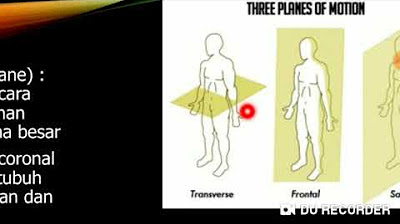Anatomie Grundlagen - Lagebezeichnungen und Ebenen am Körper einfach erklärt
Summary
TLDRThis video provides an in-depth exploration of anatomical terminology, helping viewers understand the precise language used to describe the human body. It covers essential terms related to anatomical position, directional terms like superior, inferior, anterior, and posterior, and how they help pinpoint the location of structures in the body. The video also explains the significance of anatomical planes and axes for understanding movement and positioning. Overall, it offers a foundational understanding of how professionals communicate about the human body in a clear, consistent manner.
Takeaways
- 😀 Anatomical terminology can initially seem complicated but is essential for precise communication in medicine.
- 😀 The anatomical reference position is when a person stands upright, arms extended, with palms facing forward, feet parallel, and facing forward.
- 😀 'Superior' refers to a structure above another, while 'inferior' refers to one below. For example, the head is superior to the heart, and the heart is inferior to the head.
- 😀 Terms like 'cranial' (towards the head) and 'caudal' (towards the tail) are often used synonymously with 'superior' and 'inferior' in clinical settings.
- 😀 'Anterior' and 'posterior' describe structures in front of or behind others, respectively. For example, the chest is anterior to the back.
- 😀 'Medial' refers to structures closer to the body's midline, while 'lateral' refers to those further away from the midline.
- 😀 Anatomical directions like 'right' and 'left' always refer to the patient's perspective, not the observer's.
- 😀 'Proximal' and 'distal' describe whether a structure is closer to or further from the body’s center. For instance, the thumb is distal to the shoulder joint.
- 😀 Understanding anatomical axes, such as the longitudinal, digital, and transverse axes, helps in describing body movements accurately.
- 😀 The three primary anatomical planes (sagittal, frontal, and transverse) divide the body in different ways and are important in medical imaging like CT scans.
Q & A
What is the purpose of using anatomical terminology in medical descriptions?
-Anatomical terminology helps in providing a standardized language that allows for accurate, clear, and precise descriptions of body parts, ensuring effective communication in medical contexts.
Why is it important to avoid vague descriptions like 'near the wrist' in medical anatomy?
-Vague descriptions like 'near the wrist' are imprecise, and in medical fields, it is critical to be as clear and unambiguous as possible to avoid misunderstandings or errors.
What is the anatomical position, and why is it essential?
-The anatomical position is a standardized reference point where the body is upright, arms extended at the sides, palms facing forward, and feet parallel. It is essential because it provides a consistent basis for describing the locations and directions of body structures.
What is the meaning of 'superior' and 'inferior' in anatomical terms?
-'Superior' refers to a structure located above or higher than another, while 'inferior' refers to a structure located below or lower than another.
What are the terms 'cranial' and 'caudal' used for in anatomy?
-'Cranial' refers to something positioned toward the head or skull, while 'caudal' refers to something positioned toward the tailbone or lower end of the body.
How are the terms 'anterior' and 'posterior' used in anatomical descriptions?
-'Anterior' refers to a structure that is located toward the front of the body, while 'posterior' refers to a structure located toward the back of the body.
How are 'medial' and 'lateral' used to describe anatomical positions?
-'Medial' refers to a structure closer to the body's midline, whereas 'lateral' refers to a structure positioned away from the midline, toward the sides of the body.
Why is it important to use specialized anatomical terms for left and right?
-Anatomical terms for left and right are crucial because they always refer to the patient's own left and right sides, not the observer's perspective, ensuring clarity in communication, especially in clinical settings.
What is the difference between 'proximal' and 'distal' in anatomical terms?
-'Proximal' refers to a structure that is closer to the trunk or body core, while 'distal' refers to a structure farther away from the trunk or core, typically used when describing limbs.
What are the three main axes in human anatomy, and why are they important?
-The three main axes are the longitudinal axis (from top to bottom of the body), the sagittal axis (from front to back), and the transverse axis (from left to right). These axes are important for accurately describing movements of body parts and joint functions.
Outlines

This section is available to paid users only. Please upgrade to access this part.
Upgrade NowMindmap

This section is available to paid users only. Please upgrade to access this part.
Upgrade NowKeywords

This section is available to paid users only. Please upgrade to access this part.
Upgrade NowHighlights

This section is available to paid users only. Please upgrade to access this part.
Upgrade NowTranscripts

This section is available to paid users only. Please upgrade to access this part.
Upgrade NowBrowse More Related Video

🥇 GENERALIDADES DE ANATOMÍA - Posición Anatómica, Terminología Anatómica. ¡Fácil y Sencillo!

Anatomi Fisiologi - Konsep Dasar Anatomi & Fisiologi Tubuh - Materi 1-

PART 1|| ISTILAH-ISTILAH (TERMINOLOGI) ANATOMI DALAM ILMU MEDIS

Introduction Of Anatomy Sesi 2 - Putri Halleyana Adrikni Rahman, dr., M.Kes

Ship Terminology - - Ship Parts Names with Pictures #shipterms #shipparts

ANATOMI GERAK MANUSIA (BAG. 1) : ISTILAH ARAH, BIDANG ANATOMIS DAN SUMBU ANATOMIS.
5.0 / 5 (0 votes)